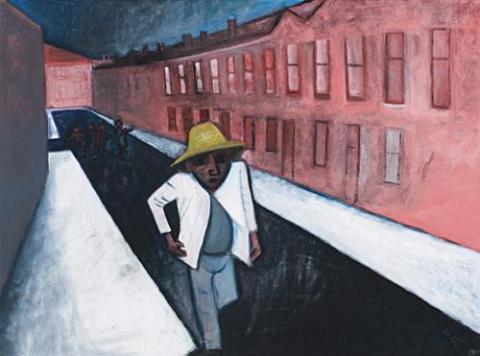MAN WALKING HOME, 1966
Robert Dickerson
oil and enamel on composition board
92.0 x 122.0 cm
signed lower right: DICKERSON
The Estate of Pro Hart, Broken Hill, New South Wales
Dickerson, J., Robert Dickerson: Against the Tide, Pandanus Press, Brisbane, 1994, pp. 84 (illus.), 146
Man Walking Home, charcoal on paper on card, 57.0 x 78.5 cm (lot 182 of this sale)
Robert Dickerson is a master of the isolated image. Whereas Charles Blackman evokes feelings of solitariness around his school girls, Dickerson concentrates more on the male- a lone jockey, a plunge on the horses, or the single image as in Man in Rushcutters Bay Park, 1965, private collection, Sydney. Two favourites are Guy, 1957, in the Newcastle Region Art Gallery and The Bank Clerk, 1958, from The Holmes à Court Collection, Perth. In the former, pinks and pale blues are employed to create an amazingly simple background of complex emptiness, while the angles of colour in The Bank Clerk emphasise anxiety and stress. The lonely street with closed doors and shuttered windows, as in Man Walking Home is another favourite Dickerson device, the presence of children playing cast into the darkness of the background of the street providing a pointed contrast to the solitary figure. There is no communication between them. Sharp angles and recessions set up contrasts within the composition, of movement anchored by stillness, the prominent placement of the foreground figure stressing the flatness of the picture plane in contradiction of the illusion of depth. Through such skilfully manipulated means the painting resonates with isolation, picked up in the colours. Cold blues and whites are opposed to the emotional warmth of the reds of the buildings; but the doors and windows are blank against outside intrusion. In response to a question about his people wearing expressions 'of apprehensions of impending doom', Dickerson replied, 'Everyone is apprehensive - look at people in the street, in traffic.'1
The autobiographical runs through most artists' work. This is especially so with Dickerson, whose forthright paintings abound with personal references. Born in Hurstville, he was a city kid, and the city that was his playground, its empty lanes, back alleys, and terraces became the settings for many of his paintings. There was boxing, the punter and racing pictures, family tribulations with very empty streets, of lawyers, and then landscapes for happier times. As art critic Elwyn Lynn once noted, 'His painting comes from a hard scrutiny of life, without the slightest desire to flatter, reform, or condemn.'2 Throughout his work, however, the most consistent and important element is isolation, which takes on a metaphorical role. Creativity requires it - the painter alone in the studio before the empty canvas, the writer at the computer, the musician, the poet - each needs to be on his own to produce. As in this painting, Dickerson's early art reveals an enjoyment of solitude, which, when combined with his aesthetics of unpretentious directness, provides food for the mind as well as the eye.
1. Quoted in Dickerson, Jennifer, op. cit, p. 136
2. Lynn, Elwyn, 'Foreword', Jennifer Dickerson, op. cit, p. 8
DAVID THOMAS
